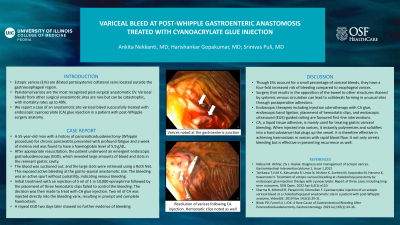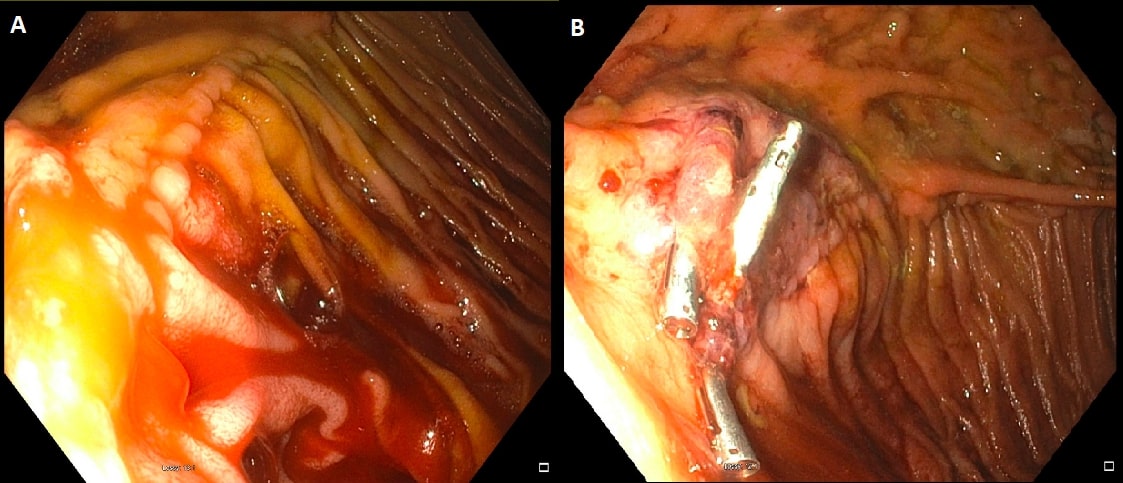Sunday Poster Session
Category: General Endoscopy
P0715 - Variceal Bleed at Post-Whipple Gastroenteric Anastomosis Treated With Cyanoacrylate Glue Injection
Sunday, October 27, 2024
3:30 PM - 7:00 PM ET
Location: Exhibit Hall E

Has Audio

Ankita Nekkanti, MD
University of Illinois College of Medicine
Peoria, IL
Presenting Author(s)
Ankita Nekkanti, MD1, Harishankar Gopakumar, MD2, Srinivas Puli, MD1
1University of Illinois College of Medicine, Peoria, IL; 2University of Illinois College of Medicine, Bloomington, IL
Introduction: Ectopic varices (EVs) are dilated portosystemic collateral veins located outside the gastroesophageal region. Peristomal varices are the most recognized post-surgical anastomotic EV. Variceal bleeds from other surgical anastomotic sites are rare but can be catastrophic, with mortality rates up to 40%. We report a case of an anastomotic site variceal bleed successfully treated with endoscopic cyanoacrylate (CA) glue injection in a patient with post-Whipple surgery anatomy.
Case Description/Methods: A 55-year-old man with a history of pancreaticoduodenectomy (Whipple procedure) for chronic pancreatitis presented with profound fatigue and a week of melena, and was found to have a hemoglobin level of 5.9 g/dL. After appropriate resuscitation, the patient underwent an emergent endoscopic gastroduodenoscopy (EGD), which revealed large amounts of blood and clots in the remnant gastric cavity. The blood was suctioned out, and the large clots were retrieved using a Roth Net. This exposed active bleeding at the gastro-jejunal anastomotic site. The bleeding was an active spurt without pulsatility, indicating venous bleeding. Initial treatment with an injection of 5 ml of 1 in 10,000 epinephrine followed by the placement of three hemostatic clips failed to control the bleeding. The decision was then made to treat with CA glue injection. Two ml of CA was injected directly into the bleeding varix, resulting in prompt and complete hemostasis. A repeat EGD two days later showed no further evidence of bleeding.
Discussion: Though EVs account for a small percentage of variceal bleeds, they have a four-fold increased risk of bleeding compared to esophageal varices. Surgery that results in the apposition of the bowel to other structures drained by systemic venous circulation can lead to collaterals forming in unusual sites through postoperative adhesions. Endoscopic therapies including injection sclerotherapy with CA glue, endoscopic band ligation, placement of hemostatic clips, and endoscopic ultrasound (EUS)-guided coiling are favored first-line interventions. CA, a liquid tissue adhesive, is mainly used for treating gastric variceal bleeding. When injected into varices, CA instantly polymerizes and solidifies into a hard substance that plugs up the vessel. Thus, CA is effective in achieving hemostasis in varices with rapid blood flow. It not only arrests bleeding, but is effective in preventing recurrence as well.

Disclosures:
Ankita Nekkanti, MD1, Harishankar Gopakumar, MD2, Srinivas Puli, MD1. P0715 - Variceal Bleed at Post-Whipple Gastroenteric Anastomosis Treated With Cyanoacrylate Glue Injection, ACG 2024 Annual Scientific Meeting Abstracts. Philadelphia, PA: American College of Gastroenterology.
1University of Illinois College of Medicine, Peoria, IL; 2University of Illinois College of Medicine, Bloomington, IL
Introduction: Ectopic varices (EVs) are dilated portosystemic collateral veins located outside the gastroesophageal region. Peristomal varices are the most recognized post-surgical anastomotic EV. Variceal bleeds from other surgical anastomotic sites are rare but can be catastrophic, with mortality rates up to 40%. We report a case of an anastomotic site variceal bleed successfully treated with endoscopic cyanoacrylate (CA) glue injection in a patient with post-Whipple surgery anatomy.
Case Description/Methods: A 55-year-old man with a history of pancreaticoduodenectomy (Whipple procedure) for chronic pancreatitis presented with profound fatigue and a week of melena, and was found to have a hemoglobin level of 5.9 g/dL. After appropriate resuscitation, the patient underwent an emergent endoscopic gastroduodenoscopy (EGD), which revealed large amounts of blood and clots in the remnant gastric cavity. The blood was suctioned out, and the large clots were retrieved using a Roth Net. This exposed active bleeding at the gastro-jejunal anastomotic site. The bleeding was an active spurt without pulsatility, indicating venous bleeding. Initial treatment with an injection of 5 ml of 1 in 10,000 epinephrine followed by the placement of three hemostatic clips failed to control the bleeding. The decision was then made to treat with CA glue injection. Two ml of CA was injected directly into the bleeding varix, resulting in prompt and complete hemostasis. A repeat EGD two days later showed no further evidence of bleeding.
Discussion: Though EVs account for a small percentage of variceal bleeds, they have a four-fold increased risk of bleeding compared to esophageal varices. Surgery that results in the apposition of the bowel to other structures drained by systemic venous circulation can lead to collaterals forming in unusual sites through postoperative adhesions. Endoscopic therapies including injection sclerotherapy with CA glue, endoscopic band ligation, placement of hemostatic clips, and endoscopic ultrasound (EUS)-guided coiling are favored first-line interventions. CA, a liquid tissue adhesive, is mainly used for treating gastric variceal bleeding. When injected into varices, CA instantly polymerizes and solidifies into a hard substance that plugs up the vessel. Thus, CA is effective in achieving hemostasis in varices with rapid blood flow. It not only arrests bleeding, but is effective in preventing recurrence as well.

Figure: A. Actively bleeding varix at the gastro-jejunal anastomotic site. B. Hemostatic clips placed, but unsuccessful in achieving hemostasis. Resolution of bleeding achieved with cyanoacrylate glue injection.
Disclosures:
Ankita Nekkanti indicated no relevant financial relationships.
Harishankar Gopakumar indicated no relevant financial relationships.
Srinivas Puli indicated no relevant financial relationships.
Ankita Nekkanti, MD1, Harishankar Gopakumar, MD2, Srinivas Puli, MD1. P0715 - Variceal Bleed at Post-Whipple Gastroenteric Anastomosis Treated With Cyanoacrylate Glue Injection, ACG 2024 Annual Scientific Meeting Abstracts. Philadelphia, PA: American College of Gastroenterology.
